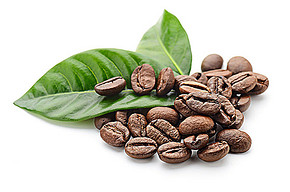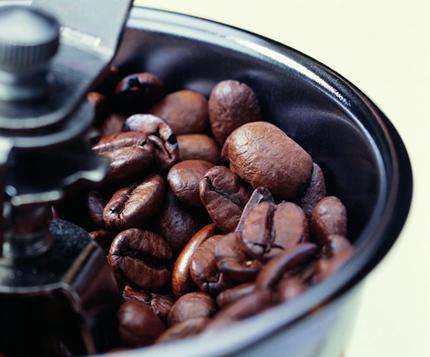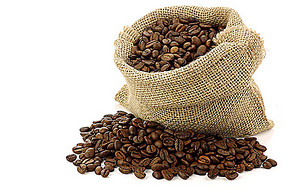How much is the coffee? -The summer coffee.
Follow the caf é (Wechat official account vdailycom) and found that Beautiful Cafe opened a small shop of its own.
How much is a cup of Rosa coffee, equivalent to more than 120 yuan?
Panamanian rose grows from 1500 meters to 1650 meters above sea level, and has a unique flavor because of its unique growing environment:
Rosa coffee raw beans have a jade-like warm texture, have a very beautiful blue-green color, smell fresh grass, peach, berry and oolong tea sweet smell that most coffee beans do not have, but the light tea fragrance is also intriguing.
Roasted cooked beans, there will be some "wrinkles" on the surface, with these "wrinkles" coffee beans are to highlight its original taste and fruit acid, if the quality of the raw bean itself is not high, it will have some miscellaneous flavors, such as turbid soil flavor, withered grass flavor and dry taste, which roasters should try to avoid. Roasted Rosa coffee beans have fresh lemon and citrus aromas and sweet honey cream flavor.

In order to highlight the characteristics and aroma of this kind of coffee beans, the baking degree is on the verge of second explosion, and two explosions and one sound are more commonly used roasting degrees, which can give play to the characteristics of beans themselves, and shallow roasting will produce miscellaneous odors. too deep roasting will lose flower aroma and fruit acidity, so the depth of roasting should be adjusted according to the characteristics of coffee beans.
The aroma of flowers and the intense sweetness of tropical fruits; these are the consistent characteristics of Rosa Coffee. With proper baking, they feel like sipping the fragrance of a bouquet of flowers.
Dry aroma: rose summer has bright dry aromas, with aromas of rose and jasmine, honey pomelo and citrus, nutty when lightly baked, (magnolia, tulips) and other flowers, milk tea, black sugar, and more advanced champagne.
Wet fragrance: also has the wet aroma of orange, but also the emergence of more floral aroma. In terms of taste, the early stage is slightly mild and subtle compared with the bright dry aroma, full-bodied caramel flavor, after cooling a little, the flower and fruit aroma gradually increases with the drop of temperature, (sweet preserved fruit, rose fruit, orange glaze jam, strawberry jam, apricot, cherry, hint of pine, vanilla, rose gradually fade, finally lemon flavor can be derived) the cold fragrance is excellent. The sweetness of the aftertaste, especially in the case of light roasting, is a test of the brightness of this coffee.
Sipping: rich Lishan special tea flavor, good oil quality, with the astringency of high-grade liquor, the lower the temperature, the more delicate the acidity, but instantly into a delicate and smooth Body filled in the mouth. The sweetness and spice of the candy echoes, accompanied by the aroma of flowers, with a lingering floral finish, sweet fruit and body.
The species of Geisha was discovered in the Rose Summer Forest of Ethiopia in 1931 and sent to the Coffee Institute in Kenya; it was introduced to Uganda and Tanzania in 1936, in Costa Rica in 1953, and Panama was introduced in the 1970s by Francesca of Dongba Seven Farm Garden. Mr. Serraxin got seeds from CATIE, Costa Rica, and started growing Rosa Coffee.
Geisha, sweeping the coffee world with the power of a hurricane, the coffee revolution is so fierce that the blue mountains of Jamaica and Kona of Hawaii, which have long occupied the throne of the coffee kingdom, have to stay away. This wild species, which originated in Ethiopia, is now widely used in major coffee producing areas after numerous battles, and its best spokesman is the "LaEsmeralda" estate from Panama.
History of Esmeralda Farm: Haines, a Swede in 1924. Elliott founded Esmeralda Farm, which was not a coffee grower but a ranch. Forty years later, Daniel Lou in 1964. Mr. Bidarson's grandfather, Luther Ruffer. Mr. Bidarson bought Esmeralda Farm in order to have an old home after retirement, grandfather Luthor. Born in Sweden, Mr. Bidarsson was president of the Bank of America and director of the United Nations Development. His son, Mr. Bradasson, moved to Panama from California in 1973. He inherited his father's farm, changed most of the farm to grow coffee in 1987, and invested in machinery and equipment for refined coffee to start the brand in 1994. While Mr. Bidarson and his wife Susan started a formal business on the coffee farm, they also raised three children, Elligo (born in Philadelphia in 1966), Rachel (born in Sweden in 1967) and Danielu (born in Panama in 1974).
In 1996, Blaise and Rachel visited a farm for sale in the Haramijun area of the Bocketi Valley, and was attracted by the beautiful farm and immediately bought it. This is Esmeralda. Daniel Lou, the third son of Haramiqiong Farm. It is in this farm that Mr. Bidasson has grown Geisha coffee that attracts the attention of the coffee world.
The pronunciation of Geisha is the same as Japanese geisha, so it is also called geisha coffee. Because the tree species are taller than ordinary coffee trees, they are originally planted in a small area of the manor and are used as windbreaks. In order to take part in the annual competition for the best coffee in Panama, the son of the manor owner searched all the coffee trees in the manor for testing, so that Geisha had a chance to appear on the stage. Since then, he has also participated in various world coffee competitions, winning a total of 11 championships.
Important Notice :
前街咖啡 FrontStreet Coffee has moved to new addredd:
FrontStreet Coffee Address: 315,Donghua East Road,GuangZhou
Tel:020 38364473
- Prev

The taste and flavor characteristics of Rosa coffee
Follow the caf é (Wechat official account vdailycom) found that the beautiful cafe opened a small shop of its own, Ruoxia is a member of the Tibika family, but became famous after leaving Ethiopia for more than 70 years, and fulfilled the saying that Ethiopia is a treasure trove of Arabica genes. Giving a variety abroad is enough to make waves in the coffee market. The dry aroma is very high.
- Next

Rosy Summer Coffee from the Emerald Manor of Panama
Following caf é (Wechat official account vdailycom) found that the Cafe Beautiful Cafe opened its own shop, Geisha, was discovered in the rose forest of Ethiopia in 1931 and sent to the Coffee Research Institute in Kenya; it was introduced to Uganda and Tanzania in 1936 and in Costa Rica in 1953. Panama was founded in the 1970s by Francis of the Seven Agricultural Garden in Dongba.
Related
- Detailed explanation of Jadeite planting Land in Panamanian Jadeite Manor introduction to the grading system of Jadeite competitive bidding, Red bid, Green bid and Rose Summer
- Story of Coffee planting in Brenka region of Costa Rica Stonehenge Manor anaerobic heavy honey treatment of flavor mouth
- What's on the barrel of Blue Mountain Coffee beans?
- Can American coffee also pull flowers? How to use hot American style to pull out a good-looking pattern?
- Can you make a cold extract with coffee beans? What is the right proportion for cold-extracted coffee formula?
- Indonesian PWN Gold Mandrine Coffee Origin Features Flavor How to Chong? Mandolin coffee is American.
- A brief introduction to the flavor characteristics of Brazilian yellow bourbon coffee beans
- What is the effect of different water quality on the flavor of cold-extracted coffee? What kind of water is best for brewing coffee?
- Why do you think of Rose Summer whenever you mention Panamanian coffee?
- Introduction to the characteristics of authentic blue mountain coffee bean producing areas? What is the CIB Coffee Authority in Jamaica?

